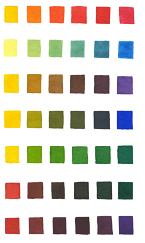
~ schedule ~ assignments ~ stories ~ crafts ~ books ~ pigments ~ websites ~ forum
words and concepts

week
1 & 2 |
words |
|
metal |
||
malleability |
||
packing structure |
||
face
centered cubic (fcc) |
||
alloy |
||
oxidation |
||
reduction |
||
a
salt |
||
a molecular solid |
||
| Conceptual questions --- | ||
|
||
|
||
|
||
|
||
|
||
|
||
|
||
|
||
weeks
3 - 5 |
words
|
|
a
salt
|
||
a
sulfur molecule, S8
|
||
redox
reaction
|
||
smelt |
||
galena |
||
cinnabar |
||
stibnite |
||
realgar & orpiment |
||
oxide |
||
sulfide |
||
| Conceptual questions --- | ||
|
||
|
||
|
||
|
||
|
||
|
||
|
||
|
||
week
6 -7
|
words
|
|
acid
|
||
base
|
||
ion exchange
|
||
precipitation
|
||
solubility product
|
||
Ksp
|
||
equilibrium
|
||
quicklime |
||
pit lime |
||
limestone |
||
gypsum |
||
| Conceptual questions --- | ||
|
||
|
||
|
||
|
||
|
||
|
||
|
||
|
||
|
||
|
||
week
9
|
words
|
|
drying
oil
|
||
binders
|
||
gum arabic
|
||
precipitation
|
||
solubility product
|
||
Ksp
|
||
| Conceptual questions --- | ||
|
||
|
||
|
||
week
9-10
|
words
|
|
elements
|
||
ionic
|
||
covalent
|
||
| Conceptual questions --- | ||
|
||
|
||
|
||
|
||
|
||
|
||
|
||
|
||
|
||
week
11
|
words
|
|
additive
color mixing |
||
subtractive mixing |
||
metameric |
||
cones |
||
absorption |
||
transmission |
||
reflection |
||
white light diffraction |
||
| Conceptual questions --- | ||
|
||
week
12
|
words
|
|
microscopy |
||
refraction |
||
index of refraction |
||
isotropic
|
||
anisotropic |
||
polarized light |
||
crossed polarizers |
||
| Conceptual questions --- | ||
|
||
|
||
|
||
|
||
|
||
|
||
|
||
| What pigments were in the painting? click here to see | ||
